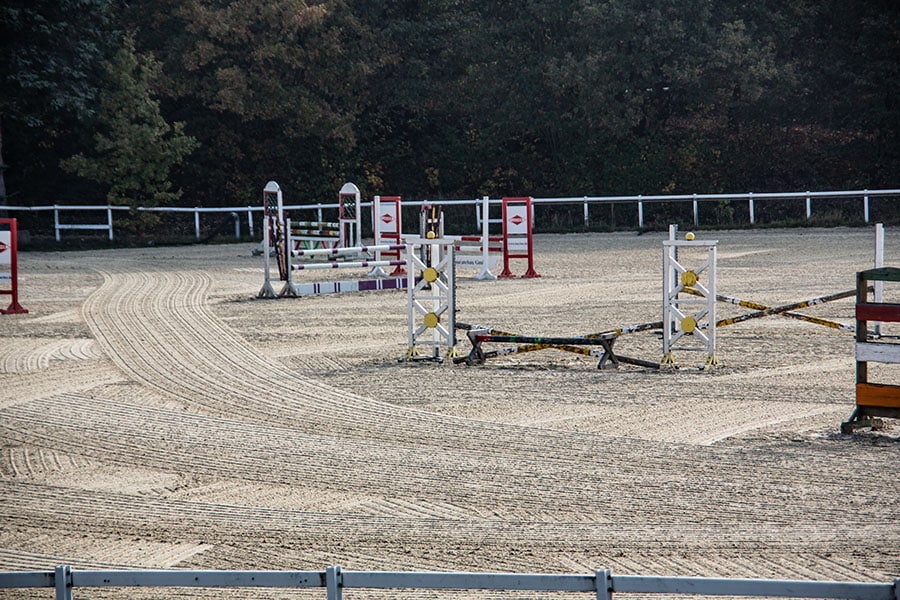Outdoor arenas are a worthwhile investment that span 10 to 20 years. In the end, they’ll produce far more revenue than the money you put into building them.
However, you must choose the right horse footing to get this kind of success, attracting competitive and casual owners alike.
Niche riders, including dressage, jumping, and hunting, all require specific riding surfaces that meet national guidelines. You can’t just mix sand or stone dust into any type of footing.
And no matter who visits your outdoor arena, they want to train and trot on trustworthy footing. It prevents dust and injury, being a mark of a state-of-the-art horse facility.
Take a look at some of the best footing products for outdoor horse arenas so you can build with future success. Then, we’ll put the riding surface in context of everything you need to build a facility that drives equestrians through your doors.
What is the Best Outdoor Riding Arena Footing?
The best footing for outdoor horse arenas depends on your facility’s needs and the needs of your riders.
Making a smart investment on footing now can save you thousands on arena maintenance later. Plus, you can grow a lifetime customer that’s loyal to facilities with high-quality arena surfaces.
Watering
For example, your facility may in Arizona dry heat where watering the arena costs thousands each day. We’ve seen arena owners pour over 6,000 gallons into the ground per day in harsh drought conditions.
Waterless horse footing, such as Arena Green, eliminates the need for watering and pays for itself in arena maintenance.
Outdoor Disciplines
Jumping and dressage arenas can only use specific outdoor footing since their riders apply for local, national, and international competitions.
One type the FEI World Cup has used is GGT Footing, which is a premier European textile and fiber blend. World-class arena builders have installed the footing in internationally recognized facilities since 1997.
It’s much easier to keep a long time equestrian at your facility when they know you respect their discipline.
Cushion
Horses need maximum cushion when trotting and performing complex movements in indoor and indoor arenas.
We recommend yoga mat footing as a viable option that helps horse hooves rebound properly. That way, they’re not as prone to ligament and tendon injuries that could end their equestrian careers.
Dressage riders that invest thousands into their animals can have peace of mind when training in your facility with plenty of cushion.
Footing Maintenance for Outdoor Arenas
Maintaining outdoor arenas is just as important as choosing the right footing. If you’re spending a large sum of money on the best horse footing on the market, it’s wise to make sure it lasts.
One daily task you or a trainer partakes in is redistributing footing materials across the footing surface. When horses run and train in the same traffic patterns, it creates compacted particles and ruts that can become chronic.
We suggest purchasing a versatile arena drag that can get the job done, attaching to whatever vehicle you have. Connecting to the back of an ATV, our team has seen arenas dragged quicker than with tractors and other machinery.
Build Your Outdoor Arena the Right Way
Horse arena footing is only one part of constructing a state-of-the-art facility that owners visit for a lifetime. You can still run into ruts, pooling, and other issues that deter loyal customers from ever coming back.
Additives don’t always solve these chronic arena problems, requiring you to take other measures. Often, we find that means starting over to build an arena that performs better for longer.
Arena Base
If you don’t purchase a base material with adequate drainage, the arena could flood after heavy storms. The issue is critical if you live in a high-rain region where downpours occur.
Also, horse owners and riders may complain of stability issues despite cushion from footing. The underlying issue for uneven riding surfaces are a weak foundation or subgrade that can’t handle the volume of horse traffic.
The good news is you can solve both issues at the same time by building with a durable and permeable arena base.
Our footing specialists know everything about assembling arenas and would love to answer your questions about how to furnish your arena base.
Dust Control
Although outdoor riding arenas don’t struggle with dust as much as indoor arenas, riders may still complain about too many particles flying in the air.
Daily complaints can quickly turn into animals inhaling too much dust, leading to respiratory and lung issues.
Dust Halt is one of many dust control products that binds dust particles to the product rather than clumping them together. Yoga mat footing reduces dust too but may need extra support from another product.
Unlike calcium chloride and magnesium chloride additives, Dust Halt is safe for horse hooves and is eco-friendly in case your riders ask.
The Right Arena for the Highest ROI
When you invest in the best horse footing on the market, you’ll see the difference in how much horse traffic the facility receives.
More owners and competitors trust your facility based on the footing surface. They know horses confidently train on it without fearing injury and perform their best.
We’re an equestrian-led team that’s in-tune with various footing types for all sorts of horse arenas.
If you have any questions about the best additives, the types of sands, or want to know more about how to build an equestrian arena, reach out today.
You can give our team a call at (877)-835-0878 to get stability where your facility needs it.
